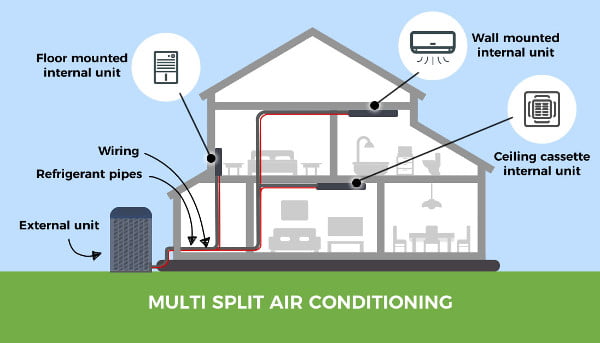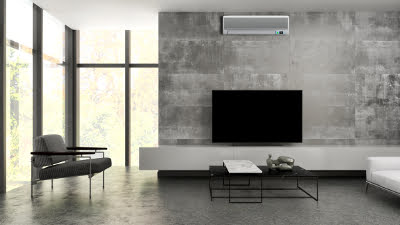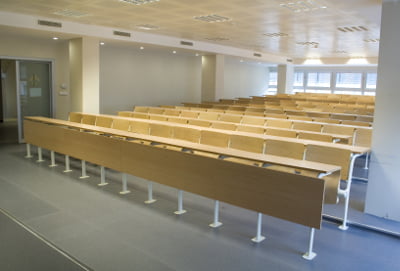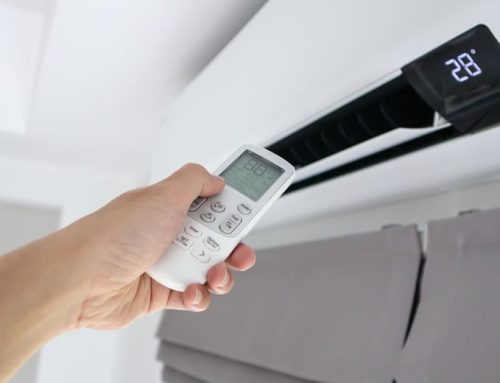Not sure what VRF is? You’re not alone. VRF air conditioning is really common in the UK – you’ll find it in offices, restaurants, shops and homes. But lots of people aren’t sure what systems the term refers to or how they work.
Whether you’re thinking about installing air conditioning or want to find out more about your existing system, you’re in the right place. Here’s everything you need to know about what VRF air conditioning is, how it works, and why it could be a good choice for you.
What’s VRF air conditioning?
VRF stands for ‘variable refrigerant flow’. A VRF air conditioning system is made up of one external unit and multiple internal units.
The main thing that makes a VRF system different to other types of air conditioning is that you can control each internal unit independently. This is called zonal control. For example, you can have different internal units set at different temperatures, or have one running while the other ones are switched off.
VRF systems can alter how much refrigerant flows to each internal unit individually – this is what gives them their name. It’s this variable flow that makes it possible to use multiple different types of internal unit in one system, and control their temperature settings separately.

VRF systems are often referred to as ‘multi split systems’ – this is because they feature multiple internal units connected to one external unit.
What’s the difference between VRF and VRV air conditioning?
Generally speaking, there isn’t much of a difference between VRF and VRV air conditioning systems. VRV – variable refrigerant volume – systems were developed by Daikin, who registered VRV as a trademark. This meant that when other air conditioning manufacturers created similar systems, they had to use a different term: VRF.
VRF is now the most common term used to describe VRF and VRV systems.
What types of VRF air conditioning system are there?
There are 3 main types of VRF system that are used in the UK. These are:
- Heat pump systems
- Heat recovery systems
- Cooling only systems
Heat pump systems are the most popular out of these 3. They can heat and cool your air, although you can’t have one internal unit heating while another one’s cooling.

Heat recovery systems are less common. They also heat and cool, but it’s possible to use one unit for heating while another one’s cooling.
Cooling only systems also aren’t as popular. These units can cool your property down in warm weather but can’t provide heating.
Want to know which VRF system would be best for your property? Get in touch and we’ll recommend the most efficient system to suit your property and budget.
4 reasons to consider getting a multi split VRF system
Different air conditioning systems suit different properties, but multi split VRF systems are particularly popular. Here are some reasons why installing one could be a great choice for your home or business.
1. Flexibility
Multi split VRF air conditioning systems can cater to a wide range of needs and budgets. This is because you can decide how many internal units you want in your system.
Just put units in a couple of rooms or areas of your property if you want to keep costs low or only need to air condition some select places. Or use several units to provide heating and cooling throughout your property. You can usually only install about 5 internal units per system, but it’s perfectly possible to have multiple systems in one property.
2. Custom comfort
It’s pretty rare to want every room in your property to be the same temperature. VRF systems give you the option to heat or cool your areas to suit their purpose. Keep a small meeting room or your home gym cool, while ensuring your public or social areas are warm and inviting.

3. Compact and subtle
Multi split VRF systems have the edge on central air conditioning because they don’t require ducting. Their relative compactness increases the types of room and building that you can install air conditioning in.
Retrofitting ducting can also be really expensive. So, if you have an existing property that you want to install air conditioning in, fitting a VRF system is almost certainly going to be cheaper.
4. High efficiency
VRF air conditioning can really help you heat and cool your property as efficiently as possible, keeping your energy bills low.
Zonal control stops you wasting energy heating or cooling areas unnecessarily. Plus, by placing units directly in the rooms you want to supply, you avoid losing energy when blowing air through ducting.
Get your ideal air conditioning
So, there are a lot of benefits to using a VRF air conditioning system to heat and cool your home or business. But, there are other ways to air condition your property too. If you want to find out more about other types of system, take a look at our handy information on central and portable air conditioning.
Whether you’ve picked a system you want or just know you need air conditioning, we can help. Fill in our quick online form and we’ll supply you with a free, no-obligation quote for a system that’s ideal for your property.






